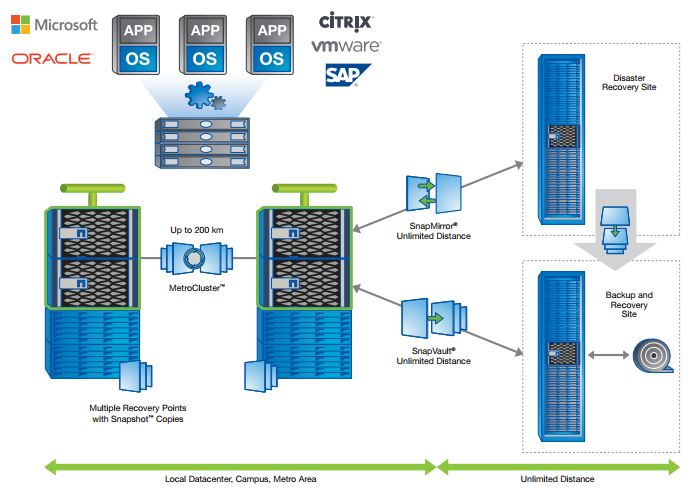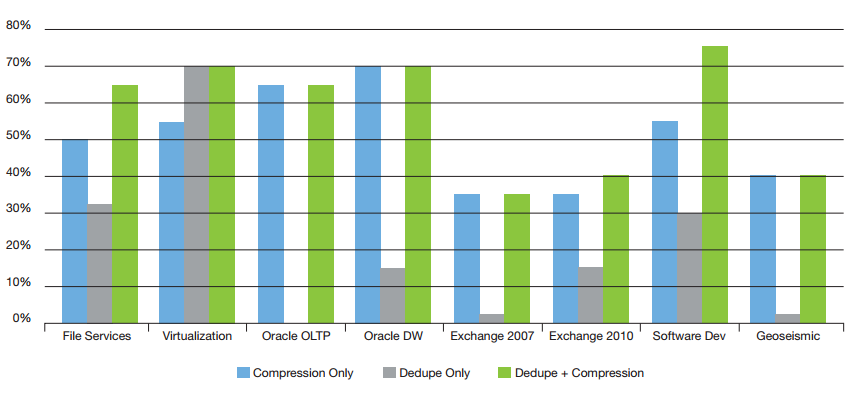NetApp Data Protection
Simplify Your Transition to the Modern Data Center

Click here to jump to more pricing!
Overview:
Despite impressive advances in technology, the exponential growth of data makes it difficult for enterprises to consistently protect their businesscritical information. This significantly increases the risk of downtime and data loss, both of which can have a negative impact on revenue, reputation, and legal and regulatory compliance. Additionally, this growth affects alignment with service-level objectives, impedes business agility, and hinders the release of revenue-generating products and services.
Traditional data protection solutions come with their own challenges:
- Complexity. More choices for data protection technologies mean more vendors and point products to manage, which leads to appliance sprawl and greater administrative overhead.
- Rising costs. Contending with massive volumes of data leaves organizations unable to optimize shrinking IT budgets and align with internal mandates to better allocate resources.
- Increased risk. The rise of shared infrastructures greatly increases the impact a single outage can have on operations.
The NetApp portfolio of data protection products, collectively termed NetApp Integrated Data Protection (IDP), includes state-of-the-art technologies employing methods based on NetApp Snapshot technology to enable efficient data transfers, reliable backups, instant restores, simplified disaster recovery (DR), and flexible multidatacenter replication configurations. Key components of the IDP portfolio are the functions available with the clustered Data ONTAP operating system. The NetApp data protection available through clustered Data ONTAP features solutions that address these challenges and reflect the new technologies that help enterprises effectively protect ever-expanding volumes of data.
NetApp also turns investment in data protection into a business accelerator by enabling you to reuse data protection infrastructure and replicated data for other purposes, such as in application development and testing and business intelligence.

NetApp Integrated Data Protection end-to-end architecture.
NetApp Data Protection with Clustered Data ONTAP
NetApp’s vision is to modernize data protection by providing solutions that enable business continuity and that are integrated, efficient, and easily managed.
Integrated
NetApp data protection maintains data availability, DR, and backup service levels with no disruptions, even during technology refreshes, upgrades, and major maintenance activity. The NetApp data protection portfolio leverages clustered Data ONTAP’s nondisruptive operations, minimizing and potentially eliminating planned downtime. Here’s how.
- High-availability features such as double-parity RAID 6 and completely redundant controllers enable better guarantees on DR and backup service levels.
- Workload mobility assures you that when you approach capacity or performance limits, workloads are moved nondisruptively to another (optimized) area within the NetApp cluster.
- The DR and backup infrastructure scales seamlessly without affecting data protection service levels, growing as the business grows. Data protection service levels are maintained even during technology refreshes.
- Sharing storage infrastructure using secure multi-tenancy allows multiple primary and data protection workloads to reside on the same physical system but to be logically and securely separated from each other.
- Integration also occurs at the application layer, covering the entire spectrum of applications and environments, whether physical or virtualized. This provides continuous availability, consistent backups and restores, minimized business interruption, less complexity, and increased productivity.
Efficient
Storage- and network-efficient data protection integrated with operational workflows leads to 50%+ direct cost savings in capacity and up to a 70% reduction in network bandwidth. Storage and network efficiency drives capex savings compared to traditional data protection. Here’s how.

Typical compression and deduplication savings (Source: NetApp internal testing).
- NetApp uses its unique Snapshot technology, through which only changed blocks are saved, as the underpinning for disk-to-disk backup and disaster recovery. NetApp Snapshot copies and disk-to-disk backups enable a “forever incremental, always full restore” model for backups. And the architecture of NetApp Snapshot copies always provides a full restore in a single pass; there’s no need to restore a recent full backup and then apply incremental updates separately. This capability not only results in direct and indirect cost savings, but also reduces or eliminates the need for tape-based backups. As an example, consider 100TB with an RPO of one day and an average weekly data growth rate of 2%. Over one year, this situation results in approximately 2PB worth of tapes. Comparing this to disk-to-disk backup using NetApp Snapshot copies, assuming an average 30% deduplication savings, we end up with approximately 200TB of disk-based data. Compared to tapebased backups, that is a 10-to-1 reduction. See Figure 2 for typical savings from NetApp deduplication and compression.
- Thin replication maintains primaryside storage efficiencies such as deduplication and compression on data transferred over the wire. This capability results in a significant reduction in storage and network use, translating to direct cost savings by using fewer disks and less bandwidth and indirect cost savings through reduced footprint, power, and cooling. Thin replication also enables more frequent transfers relative to traditional replication, minimizing data loss in the event of a disaster. Following a disaster, businesses can recover from a more recent copy of their data, serving to improve overall availability levels.
- NetApp Snapshot copies and backups are stored in native format. One benefit of this is the ability to turn backup copies into an asset that drives business with virtual copies. This allows customers to improve their business by reusing their backup data for other purposes, such as development, testing, analytics, and so on. And when the backup copies are used, there is zero impact on the production system.
- Efficient sharing of storage infrastructure is enabled through secure multi-tenancy. Secure multi-tenancy allows multiple primary and data protection workloads to reside on the same physical system, but to be logically and securely separated from each other. Sharing infrastructure allows optimal hardware and resource utilization, further reducing cost.
- You can leverage one thin-replication data stream to create a single repository that maintains both the active mirror and prior point-in-time copies. In addition to enabling failover to an earlier point in time (to recover from mirrored corruption), this also eliminates the need for a separate infrastructure to maintain backups at the DR site. You can therefore reduce DR site storage costs by up to 40% (because there is only one baseline copy for both the mirror and the backup copies).
Easily managed
NetApp’s unified architecture with built-in data protection allows agile operations. This leads to lower opex when compared to siloed approaches to storage and data protection from other vendors, which require multiple management consoles. This benefit reduces risk and IT overhead by standardizing data protection processes on a unified single architecture (clustered Data ONTAP) for primary and secondary storage requirements. A unified architecture also means that there are fewer systems to manage, which leads to a smaller footprint in your data center and fewer administrators to maintain and manage these products. Here’s how.
- NetApp is the only storage vendor to offer storage- and network-efficient replication across entry, midrange, and high-end systems. NetApp IDP empowers storage administrators to manage backup and DR, often eliminating the need for specialized administrators to manage disk-todisk backup, DR, and tape.
- NetApp offers several unique operational advantages with data protection products within our operating system, clustered Data ONTAP. Clustered Data ONTAP includes capabilities that span the spectrum of data protection needs, from zero data loss and near-zero downtime through synchronous mirroring to regional distance disaster recovery. All of this enables minimal data loss and downtime and costoptimized backup and recovery, providing forever incremental backup and near-instant reliable restores.
- Additionally, when performing DR failover testing, customers can employ NetApp virtual copies to test DR workflows without absorbing a performance or capacity overhead and without DR testing downtime. Because testing on the virtual copy eliminates the need to break the mirror between sites, DR failover testing can be performed during normal business hours, reducing cost and risk.
Summary
NetApp data protection, as part of our IDP portfolio and in conjunction with clustered Data ONTAP, plays a key role in improving data availability while addressing data growth challenges, allowing IT professionals to focus on business growth.
To learn more, here is some information about some key NetApp IDP products.
- NetApp Snapshot copies are lowimpact, space-efficient, point-in-time copies of data and are considered the basic entity of data protection. The products discussed in this solution brief extend Snapshot copies beyond the localized domain to enable sophisticated service levels for availability and protection.
- SnapMirror software provides regional data protection by enabling RPOs and RTOs on the order of minutes through asynchronous thin replication and near-instant failover and failback mechanics. In addition, NetApp’s industry-leading ability to fail over to a specific point in time in the DR copy enables you to quickly recover from mirrored data corruption.
- SnapVault software provides diskto-disk backup by enabling subhourly RPOs through a single baseline copy and only incremental transfers thereafter, resulting in the ability to store years’ worth of backup data. Restores are near instantaneous, offering low RTOs and reduced reliance on or complete elimination of tape-based backups.
- MetroCluster software combines array-based clustering with synchronous mirroring to deliver continuous availability and zero data loss.
- SnapProtect software combines high-speed NetApp Snapshot copies and replication with tape to reduce risk of downtime and data loss. Its single management console lets you create, catalog, and manage application-aware Snapshot copies across disk-to-disk-to-tape processes.
- SnapManager software is a suite of intelligent tools that allow applications and storage to coordinate activities to make backup fast and space efficient, speed the restore process, and simplify common data management tasks.

